Physical Address
304 North Cardinal St.
Dorchester Center, MA 02124
The most important upper airway (UA) soft tissue obstruction site is the soft palate.
The one-handed face-mask ventilation (FMV) technique airway maneuver is the chin-lift/head extension (CL/HE) maneuver applied in the sagittal plane (on the occipito-atlanto-axial joint). The two-handed airway maneuver is the jaw thrust applied in the transverse plane (on the temporomandibular joints).
The chin elevation (by head extension or mandibular advancement) can be estimated by the increase of the chin–sternum (UA stretching) and chin–cervical spine (UA enlargement) distance.
The objective marker for the CL/HE is the head extension angle (optimal = 42 degrees), and for the mandibular advancement, the distance achieved between the mandibular and maxillary incisors (optimal = 16.2 ± 3.2 mm).
The objective markers for the outcome of an FMV attempt are the tidal volume, airway pressure, and end-tidal CO 2 . An unexpected difficult mask ventilation (DMV), just like an unexpected difficult intubation attempt, should be quickly diagnosed using objective markers. Oxygen desaturation is a late sign of FMV failure.
The most efficient airway technique is the triple airway maneuver that combines a simultaneous CL/HE with a jaw thrust and an open mouth.
The traditional escalating FMV approach (from simple to complex techniques) deters the operator from tailoring an optimal first response to the predictors of an expected DMV producing extended periods of apnea.
The oropharyngeal airway is an underused device. It should be used with the first attempt in the expected DMV in obese, obstructive sleep apnea, edentulous, and fixed cervical spine patients and early in an unexpected DMV attempt.
Core airway management skills common to all prehospital, emergency medicine, critical care, and anesthesiology providers begin with the recognition of airway patency, as well as the familiarity with the tools and techniques to maintain oxygenation and ventilation before invasive airway management. Too frequently, many caregivers believe that definitive airway management necessitates intubation of the trachea. Noninvasive management of the airway, of which face-mask ventilation (FMV) represents the most time-critical procedure in patients with acute respiratory failure, is an essential skill for providers tasked with caring for critically ill patients. Establishing and maintaining a patent airway has been the cornerstone of resuscitation and life support since the technique of cardiopulmonary resuscitation was introduced in 1961 by Safar and colleagues. Despite the relative deemphasis on airway management in current American Heart Association (AHA) Resuscitation guidelines (often misinterpreted by professionals and laypeople), airway management with noninvasive methods and tools represents a vital component of preserving and restoring life to critically ill patients. This chapter will specifically discuss simple tools and methods to achieve airway patency as well as the use of the FMV for passive, assisted, and active ventilatory support. Additionally, we will discuss the functional anatomy of the upper airway (UA) and its contribution to airway patency and obstruction.
FMV and the management of the nonintubated UA are central to the concept of continuous patient oxygenation. The face mask (FM) is the oldest airway management device in continuous use since 1847, when British physician John Snow introduced it for the administration of inhalational anesthesia. The bag-valve-mask (BVM) device (otherwise known as the Air-Shields-Manual-Breathing Unit [AMBU]) is a ubiquitous ventilation system used across prehospital and hospital environments that retains its relevance even in the era of advanced airway management devices. , Although FMV is apparently intuitive to perform and master with BVM or anesthesia circle systems, the technique has proven difficult to learn, retain, and apply in critical situations by inexperienced providers. FMV represents an essential backup skill to failed attempts at supraglottic airway (SGA) or endotracheal tube (ETT) placement (and thus is portrayed as such in all of the guidelines for difficult airway management). In the critically ill patient its effective use prior to tracheal intubation can reduce the incidence of severe hypoxemia. Therefore competency in this procedure must be reinforced in caregivers whenever possible.
A recent innovation to simplify FMV for novice, as well as experienced, rescuers is the use of automatic resuscitation management systems (ARMS), which are flow-controlled oxygen-powered resuscitators to simplify mask ventilation. These devices allow the use of both hands to ensure adequate mask seal, including proper airway maneuvers, such as head-tilt and jaw thrust, and use a flow-controlled system that prevents overpressurization of the airway in the presence of airway obstruction. A study of 104 prehospital providers tasked with FMV in anesthetized patients using standard BMV systems compared with an oxygen-powered automated resuscitator unit (Oxylator FR-300) demonstrated reduced gastric insufflation and improved tidal volume (TV) per respiratory cycle. This study suggests that the use of ARMS devices can simplify and improve the quality of ventilation via FM in novice healthcare providers and that more investigation in simplifying FMV is indicated in this area. An example of the use of an ARMS unit with capnography monitoring is provided in the video supplement to this chapter ( ).
It is important to state that the plethora of invasive airway management devices in use today (such as SGAs) has been said to have “cannibalized the experience of younger anesthetists” with the FMV technique, leading to inconsistent and suboptimal practice. Current and future emphasis on acquiring and maintaining prowess in the FMV technique should be a goal of training programs in anesthesiology, emergency medicine, and critical care as well as prehospital providers.
Noninvasive airway management seeks to maintain UA patency with minimal equipment and interventions. We shall now review the pertinent anatomy and physiology of the UA, as it applies to providing clinically effective maneuvers to relieve obstruction to ventilation. The UA extends from the anterior nares or lips to the larynx and includes two cavities (nasal and oral), which subdivide the pharynx. The adult pharynx is a 12- to 15-cm-long convoluted and collapsible muscular tube that is subdivided into functional compartments: nasopharynx, velopharynx (retropalatal), oropharynx (retroglossal), and laryngopharynx (retroepiglottic) ( Fig. 18.1 ). The cervical spine defines the solid posterior wall of the UA, while soft expandable (and collapsible) tissues form the anterior and lateral pharyngeal wall. The pharynx supports deglutition, phonation, and respiration. The UA is a dynamic structure defined by the interaction between soft tissues (muscle, mucosa, lymphatic structure) and enclosing solid structures (bones posteriorly as the cervical spine and cartilages anteriorly and inferiorly as the thyroid cartilages). In a supine unconscious patient the soft tissues collapse posteriorly and medially, generating UA obstruction. To relieve the UA obstruction in such a case, the provider applies airway maneuvers by manipulating two solid structures (the cervical spine and the mandible) to stretch the anterior neck structures, thus mobilizing and tensing the collapsed soft tissue structures.
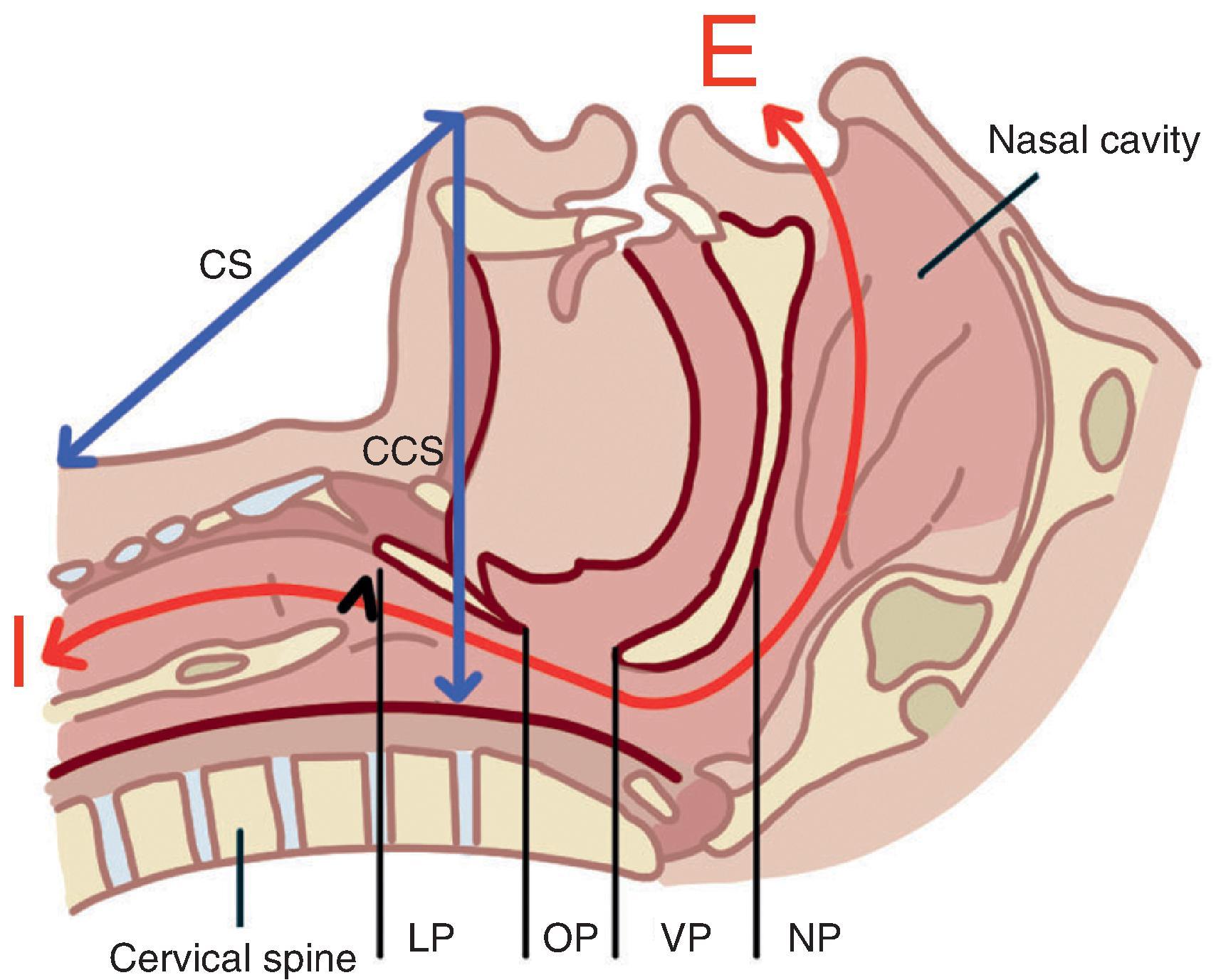
Patency in the UA is maintained by the balance between the inward narrowing forces (negative airway pressure during inspiration and the effect of gravity) and the outward dilating forces (pharyngeal dilator muscles). Pharyngeal dilator muscles are dependent on efferent neural control to maintain UA patency. When neural control of the pharyngeal dilator muscles is impaired or abolished by sedatives, intoxicants, anesthetics, REM sleep, or neuromuscular disease, the UA collapses, and airway obstruction ensues. Failure of UA patency leading to upper airway obstruction (UAO) can occur at several anatomic sites from the nasal cavities to the larynx and is highly dependent upon the anatomic and physiologic state of the patient.
The nasal ventilation route (with the mouth closed) has five possible obstruction sites: the nasal cavities and nasopharynx, soft palate, base of the tongue, epiglottis, and glottis (glottic closure with the extreme of laryngospasm) (see Fig. 18.1 ). Ventilation via the oral route (with the mouth open) has three sites of potential obstruction: the base of the tongue, the epiglottis, and the glottis. Of these potential airway obstruction sites, two respond consistently to externally applied airway maneuvers (the base of the tongue and the epiglottis). The following is a summary of the potential sites of UAO and the effects of sedative medications.
Nasopharyngeal obstruction can occur because of physical deformities, such as septal deviation and nasal foreign bodies (as seen in children) and physiologic derangements, such as allergic rhinitis or epistaxis. Preprocedure assessment of nasal patency can be evaluated clinically by requesting the patient to breathe alternatively through one nostril while gently blocking the other with a fingertip. The assessment of airflow in this manner will allow the clinician to predict the degree of airway obstruction as a result of restriction of nasal airflow and will also help identify the laterality of the appropriate nare for nasopharyngeal airway (NPA) placement, should that become necessary.
Safar radiographically confirmed the role of the tongue in UAO in the unconscious patient in his seminal work on exhaled air-rescue (mouth-to-mouth) breathing. He also correlated neck flexion with epiglottis downfolding and soft palate obstruction. A more recent assessment of the tongue’s contribution to UAO during anesthetic induction using ultrasound scanning of the hypopharynx did not indicate that the tongue is the major cause of airway obstruction. The soft palate is considered a primary site of UAO in unconscious or anesthetized patients, because it is the most compliant structure in normal and in obstructive sleep apnea (OSA) subjects. Boidin demonstrated in anesthetized, nonparalyzed patients using flexible bronchoscopy that the epiglottis has a more important contribution to UAO than the tongue, as it closes the flow of gas to the larynx when resting against the posterior pharynx.
Drug-induced UAO generated by propofol, sufentanil, isoflurane, sevoflurane, and dexmedetomidine is difficult to compare, because there is no reliable pharmacodynamic indicator of the depth of unconsciousness. Ketamine preserves the hypopharyngeal size, whereas the neuromuscular agents generate profound relaxation of skeletal muscle activity (including the upper esophageal sphincter). In sedated patients reduction of UA patency occurs to a greater extent at the level of the soft palate and the epiglottis than at the level of the tongue. Dexmedetomidine, compared with propofol, may produce less UAO in light to moderately sedated patients but not in patients under deep sedation. Ketamine may preserve UA patency better than either propofol or dexmedetomidine.
Partial UAO is insidious in onset, leading to hypoxemia, hypercapnia, and respiratory acidosis. Clinical signs are noisy breathing (inspiratory stridor), use of accessory muscles, tachycardia, tachypnea, paradoxical chest, abdominal movement (“see-sawing”), agitation, reduced consciousness level, and cyanosis as a late sign. Complete UAO with the absence of airway noises is a critical event and, if left untreated, leads rapidly to hypoxia and cardiac arrest.
The site of airway obstruction may change during the respiratory cycle. In a sedated/anesthetized patient inspiratory efforts tend to cause pharyngeal collapse because of negative inspiratory pressure on the tissues of the pharynx, tongue, and epiglottis. In the unconscious patient inspiratory obstruction can be generated by any of the collapsible sites.
Expiratory UAO is less well known and understood. In a sample of paralyzed patients the incidence of expiratory UAO with the mouth closed was 34%. The obstruction site was the velopharynx, where the soft palate acts as a one-way valve blocking the nasal egress of gas. Expiratory UAO should be suspected in all cases of ineffective FMV that cannot be corrected by routine airway maneuvers. Positive pressure ventilation in the context of an inadequate airway maneuver may forcefully open the airway during inspiration followed by collapse as a result of low airway pressure in expiration. The “poof sign” raises clinical suspicion for expiratory UAO: forced egress of gas through a closed mouth indicating forced diversion from the nasal route. Other clinical signs of expiratory UAO are subtle: chest rise but not fall (breath stacking) and lack of substantial end-tidal CO 2 (EtCO 2 ) waveform. Insertion of an oral or nasal airway will bypass the soft palate obstruction in inspiration and expiration.
Specific cases of UAO can be related to gender, age, and body habitus factors. Male predisposition to pharyngeal collapse is attributed to an increase in the length of the vulnerable pharyngeal airway, as well as an increased soft palate size. Mechanisms that may predispose to pharyngeal collapse in elderly patients are the decrease in negative pressure reflex, increase in the deposition of parapharyngeal fat, increased pharyngeal airway length in older women, and “acquired” retrognathia. Also, rhinitis in the elderly is a common but often neglected source of nasal obstruction. OSA in obese patients is a risk factor for UAO because of excess adipose tissue deposition in the anterior and especially lateral parapharyngeal walls, narrowing the UA and increasing the wall compliance and the extraluminal pressure. The anatomic imbalance between increased soft tissue volume within a limited craniofacial bony enclosure defines the severity of the OSA and airway obstruction. OSA in nonobese patients is related to a caudal positioning of the hyoid bone. The tongue in these patients may be enlarged and expanded anteroposteriorly, as well as caudally, conditions that may result in an increased pharyngeal length and an increased distance from the mandibular plane to the hyoid. Other pathologic conditions related to UAO are tonsillar hyperplasia; oral, maxillary, pharyngeal, or laryngeal tumors; airway edema after prolonged UA manipulation; laryngeal spasm; external compression by large neck masses and neck hematoma; and UA trauma.
Deliberate manipulation of a patient’s head to achieve craniocervical extension at the occipito-atlanto-axial joint is the airway maneuver that defines both the chin-lift/head extension maneuver (CL/HE) and the extent of mouth opening. Patients with poor craniocervical extension (because of advanced age, trauma, cervical spine disease) may demonstrate a restricted CL/HE and mouth opening, conditions that can complicate both invasive and noninvasive airway management. A short thyromental distance acts as a surrogate for inadequate head extension. , The temporomandibular joints (TMJs) are synovial articulations between the mandible and the temporal bones and allow both rotational and translational mandibular movement. Two types of movements occur naturally in the TMJ, namely, rotational (the movement that occurs when the mouth opens and closes around a fixed axis within the TMJ) and translational (the mandible advances anteriorly by the sliding motion of the condyles in the TMJ). Mandibular advancement or jaw thrust can be initiated only after translational movement has occurred. The cervical spine and the occipito-atlanto-axial joint are positioned in the sagittal plane, whereas the TMJs and the mandible are positioned in the transverse plane. These are the planes where optimal airway maneuvers should be implemented on the specific joints.
Understanding the direct anatomic links between the obstructing soft tissues and the mobile solid structures is essential to understanding the mechanism of action of airway maneuvers ( Fig. 18.2 ). The tongue (genioglossus) has direct links with the mandible. The epiglottis is a mobile cartilaginous structure connected to the thyroid by the thyroepiglottic ligament (which acts as a hinge) and to the hyoid bone by the hyoepiglottic ligament (which acts as a lever). The epiglottic maneuverability is therefore hyoid dependent. The hyoid bone provides attachment to the muscles of the floor of the mouth, the tongue, the larynx, the epiglottis, and the pharynx. The hyoid is the central point of a muscular hammock that connects suprahyoid (mandible, tongue) and infrahyoid (larynx, styloid, sternum, clavicles) structures. The stretching of this muscular hammock along with the deep cervical fascia and platysma by the use of airway maneuvers will displace anteriorly the tongue-hyoid-thyroid-epiglottis complex and stiffen and dilate the pharyngeal airway. The soft palate connects only to bordering soft tissues (palatoglossus, palatopharyngeus, and tensor palati) without direct structural connection to mobile solid structures. As a result of their direct connections to bony structures, the tongue and the epiglottis respond consistently to external airway maneuvers, which can be externally manipulated, whereas the soft palate does not because it lacks direct connections to structures. Relief of an obstructed UA is achieved through manipulation of the bony structures to elevate the chin of the supine patient and effectively enlarge the solid space occupied by the soft tissues (see Fig. 18.1 ).
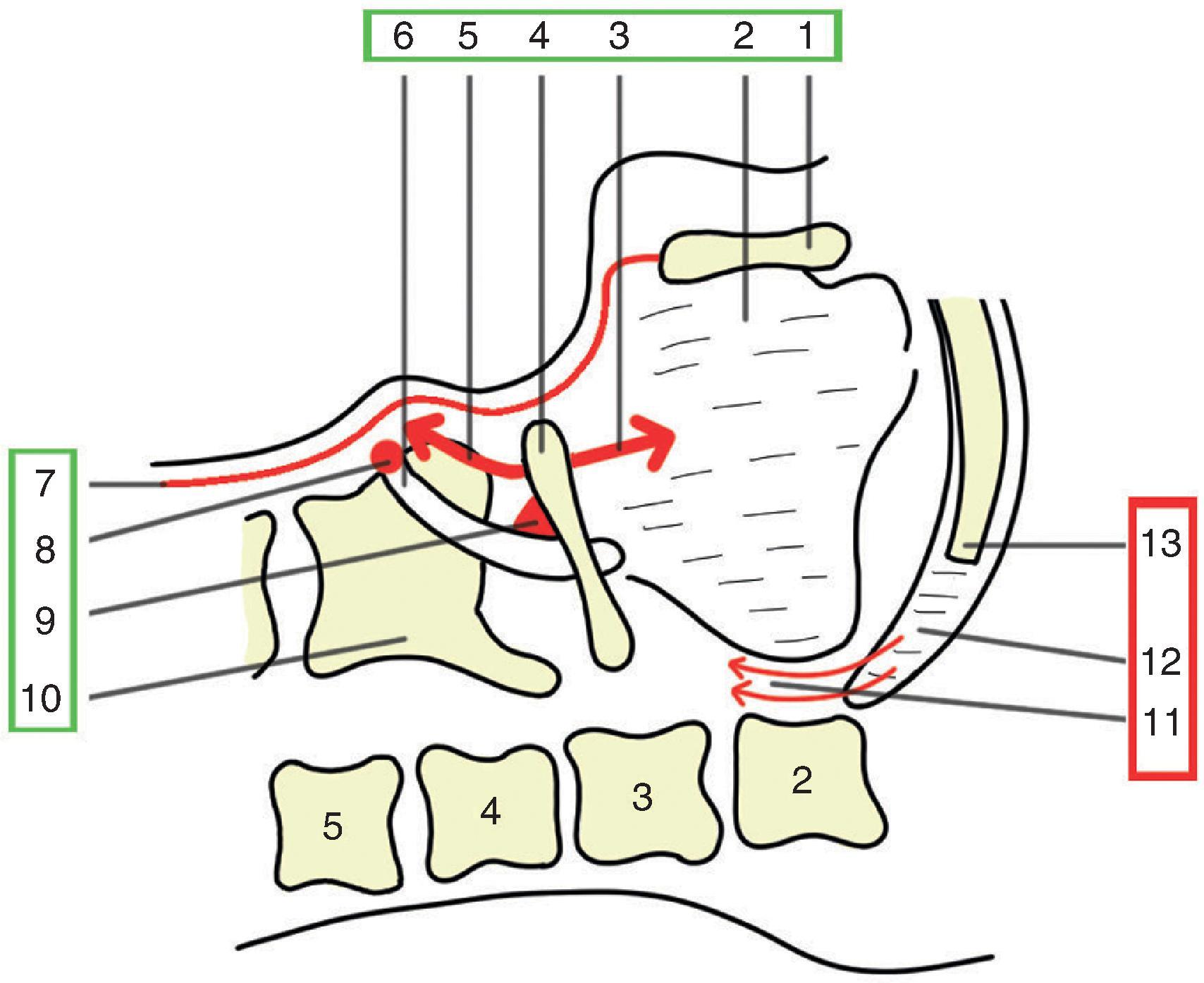
Airway obstruction unrelated to soft tissue collapse is generated by laryngospasm and glottic closure, often in response to a noxious stimulus at the level of the larynx and is accomplished by the contraction of the external laryngeal muscles. Resolution of laryngospasm (with attendant glottis closure) can occur spontaneously with time and with gentle positive pressure applied through mask ventilation if appropriate (stable vital signs with adequate oxygenation maintained per pulse oximetry monitoring) or through the administration of medications (neuromuscular relaxant medication such as succinylcholine or rocuronium, or hypnotic medications at the discretion of the clinician). Posterior to the larynx, the upper esophageal sphincter is located at the lower end of the pharynx and has two major functions: to prevent air from entering into the esophagus during breathing and to prevent the reflux of esophageal contents into the pharynx.
The validated airway maneuvers are two-handed techniques, described by Elam and colleagues for an expiratory air ventilation applied in resuscitation (i.e., mouth-to-mouth resuscitation) without a BVM system. UA soft tissue structures are anteriorly displaced with the elevation of the chin, and the anterior neck structures are stretched, producing tension in these tissues that support airway patency in patients with a relaxed UA tone. ,
The CL/HE maneuver engages the occipito-atlanto-axial joint and the cervical spine. The hands are positioned in the sagittal plane: one hand is placed underneath the mentum and elevates the chin, while simultaneously, the second hand generates downward pressure on the forehead. The CL/HE maneuver is performed with the mouth closed. In healthy awake supine patients maximal head extension is 42 degrees. This angle can be estimated during an FMV attempt as the angle between a horizontal line (longitudinal axis of the operating room bed) and the longitudinal axis of the FM at the cushion level. It may be used as an objective marker for a CL/HE attempt ( Fig. 18.3 ). Older patients often have restricted cervical spine movement with suboptimal head extension due to age-related pathologic changes.
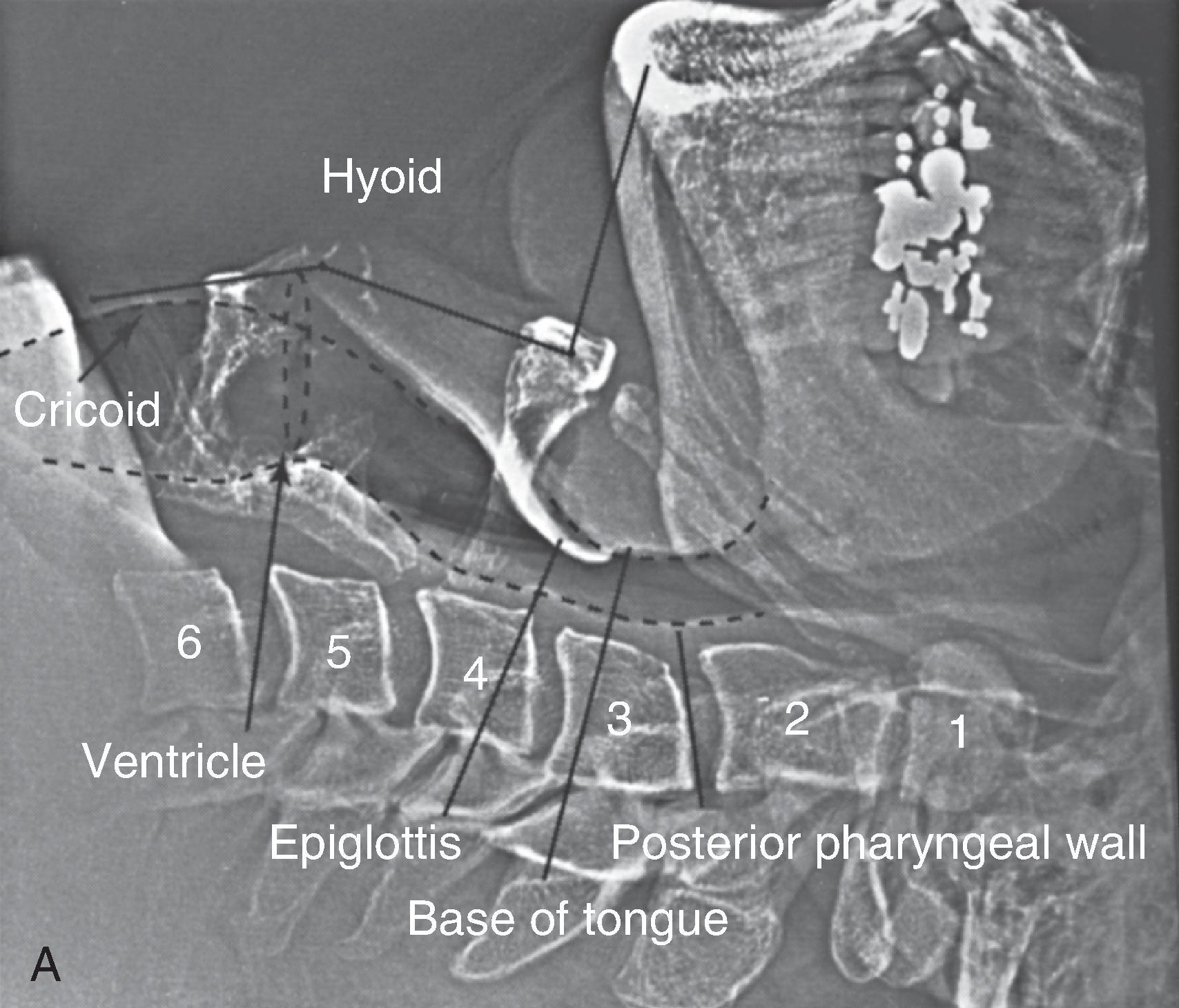
The jaw thrust engages the mandibular rami to subluxate the TMJs. The hands are in the transverse plane positioned on the ascending rami of the mandible and forcefully advancing the mandible, placing the mandibular incisors anterior to the maxillary incisors with the mouth open ( Fig. 18.4 ). The mandible is readily retracted into the TMJ once the bilateral maneuver is concluded. The jaw thrust maneuver is initiated and maintained with two hands. In normal adults under propofol anesthesia, maximum mandibular advancement is required to restore the pharyngeal airway to its preanesthetic size. This corresponds to 16.2 ± 3.2 mm mandibular incisor advancement anterior to the maxillary incisors. The distance between the mandibular and maxillar incisors may be used as an objective marker of a successful jaw thrust. Mandibular advancement generates less motion at an unstable C1–C2 level when compared with the CL/HE.

The triple airway maneuver is a two-handed technique that involves applying a simultaneous CL/HE maneuver with a jaw thrust and an open mouth. It is the most efficient technique to relieve airway obstruction in general and relieves UAO at the level of the soft palate ( Fig. 18.5 ).
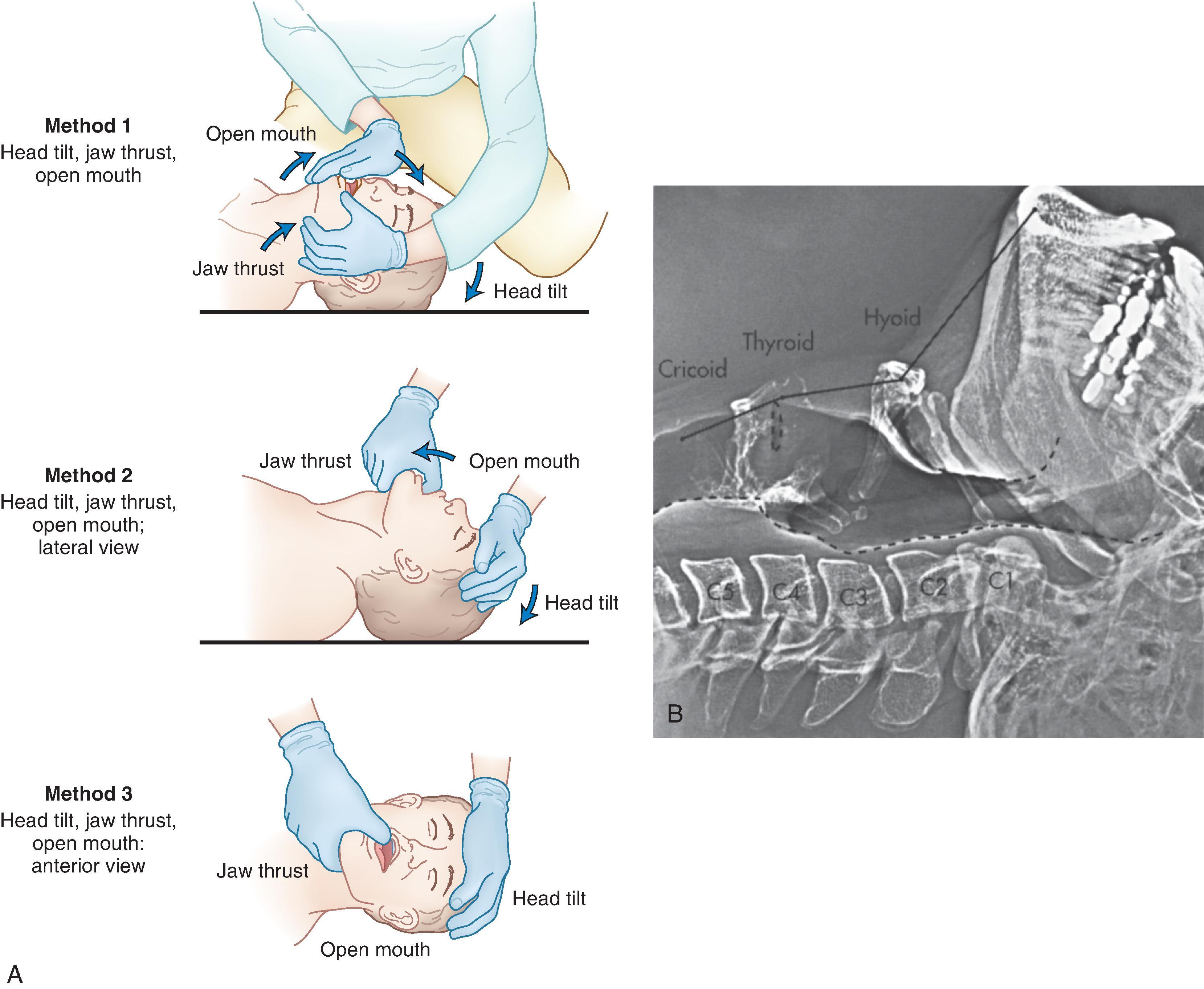
Elevation of the chin by head extension and mandibular advancement increases the mentum–cervical spine distance, thus enlarging the bony enclosure and increasing the mentum–sternum distance, stretching the anterior neck structures. Airway maneuvers should be maintained throughout the respiratory cycle.
The resuscitation/anesthesia face mask (RAFM) is typically the starting point for linking a positive pressure generating device to a patient’s airway. Although FMs have different materials, shapes, types of seals, and degrees of transparency, all are composed of three main parts: a body, a seal (or cushion), and a 22-mm connector ( Fig. 18.6 ). The body is the main structure of the mask and the primary determinant of the mask’s shape. As the body of the mask rises above the face (so as not to be completely flush to the face), all FMs increase ventilatory dead space. However, this is rarely clinically significant for spontaneous or controlled ventilation. The seal (or cushion) is the rim of the mask that contacts the patient’s face from the bridge of the nose superiorly along the face inferiorly to the tip of the chin. The most common type of seal is an air-filled cushion rim. The connector is positioned at the top of the body and provides a 22-mm female adapter for adult and large pediatric masks or a 15-mm male adapter for small pediatric and neonatal masks to connect to a BVM or a standard ventilator breathing circuit.
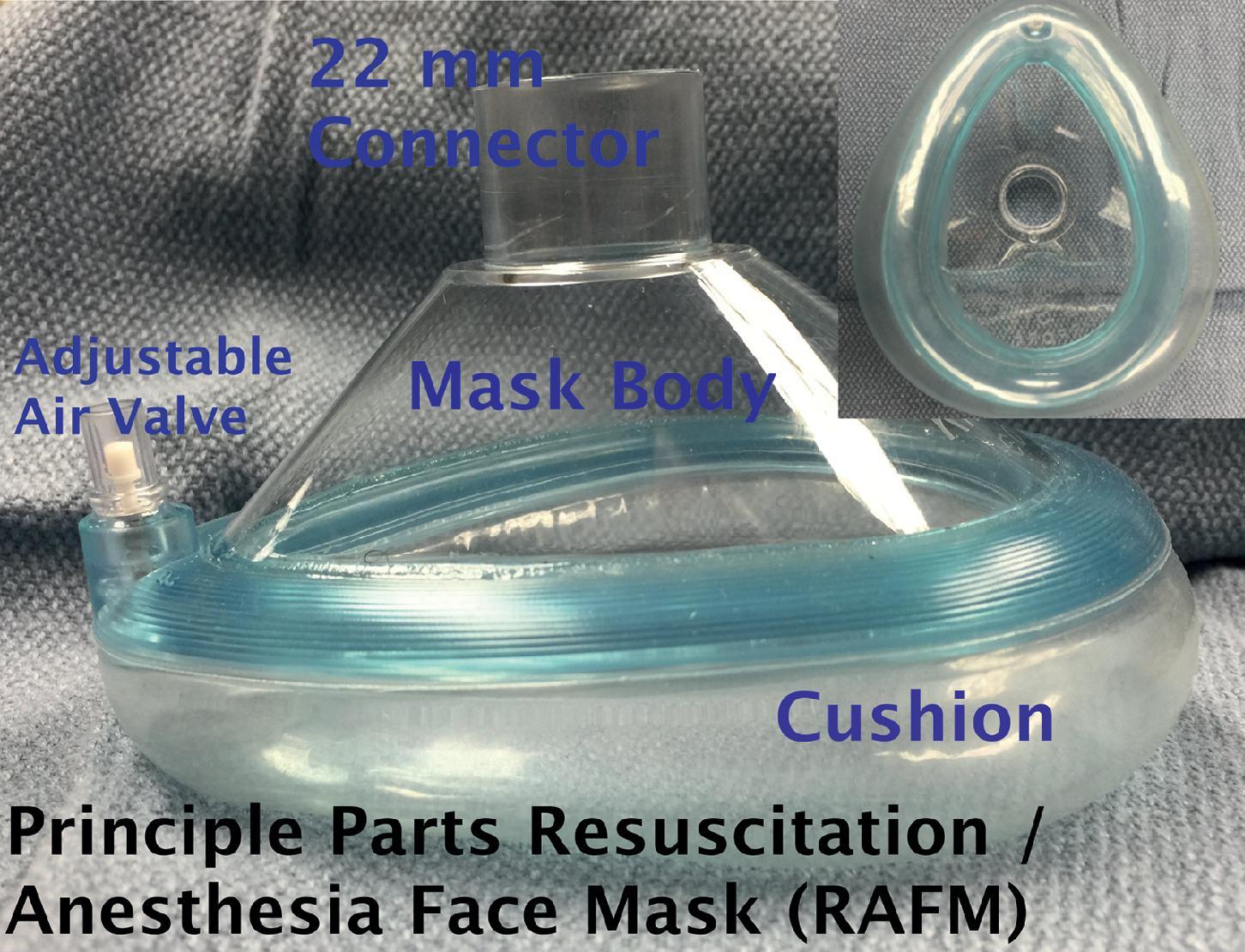
A collar with hooks allows a retaining strap to be attached to hold the mask to the patient’s face. The precise application of the straps (crossed or uncrossed) is a matter of preference and is usually the result of a trial-and-error process to find the best seal for each individual patient. Mask retaining straps can be placed below the occiput and connected to the mask collar. This technique may compromise the airway patency by flexing the head on the neck and limiting the ability to generate a jaw thrust. The head strap may improve the seal at the expense of the airway patency. A two-handed technique should be used to optimize the seal and the airway maneuver before using a head strap. Also, the presence of the collar defines the dome surface available for any grip dictating and limiting the provider’s technique. The collar has been kept on the dome since the 1880s in spite of the fact that it is rarely used. It should be applied only when needed.
The disposable, single-use, transparent plastic RAFM is the most prominently used mask in modern-day hospital and prehospital use ( Fig. 18.7 ). RAFMs are constructed with a high-volume, low-pressure cushion that can be adjusted to seal to a variety of face shapes with the addition or withdrawal of air from the valve present on the mask. Some cushions are factory sealed and lack a valve. RAFMs are not constructed with accommodations for the curve of the chin (as are the “aviator”-style masks that are used for bilevel positive airway pressure therapy) and, as such, can complicate attempts at establishing a proper mask seal during controlled ventilation. The sides of the mask are somewhat malleable to adjust to wide or narrow faces. This can be achieved only with a grip that controls both sides of the face mask and allows the control of the whole mask and lateral pressure on the dome. The asymmetrical ergonomic FM with the connector off-center is designed to accommodate and to reinforce the one-hand “chin-lift” grip.
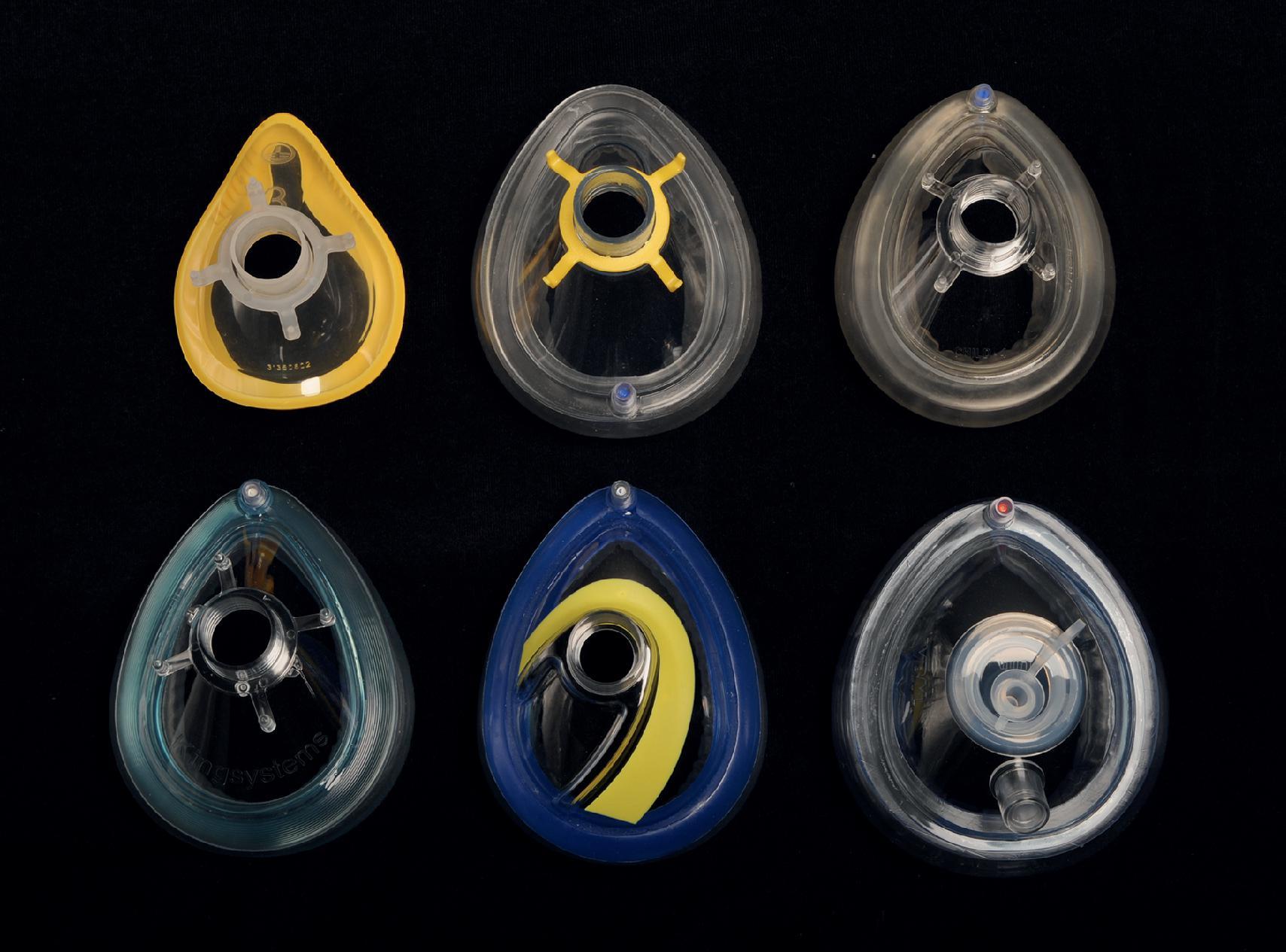
The proper use of an FM assumes an optimal first attempt for an effective seal with the patient’s face and an airway maneuver for the patency of the UA. The seal should permit maintenance of an airway pressure of 20 to 25 cm H 2 O with minimal or no leak. The mask should comfortably fit the hand of the user and the face of the patient. If the mask is too long, the face can be elongated 1 to 2 cm by placing an oropharyngeal airway (OPA). If the mask is too short, it can be moved 1 to 2 cm cephalad along the bridge of the nose to make a good seal at the patient’s chin. Careful attention is required to avoid ocular trauma. Several methods are described for holding the mask, but regardless of the precise method chosen, objective monitoring of the technique (seal, airway maneuver) and outcome is necessary.
Airway devices to support noninvasive ventilation are used in the unexpected difficult mask ventilation (DMV) to supplement an ineffective technique or preemptively with a first attempt in the expected DMV. The next sections address some of the more commonly available devices and discuss techniques for insertion, indications, contraindications, and complications.
Become a Clinical Tree membership for Full access and enjoy Unlimited articles
If you are a member. Log in here